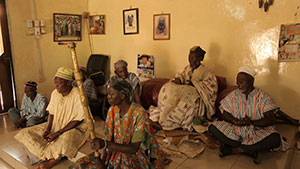
Introduction to the Documentary Video and Discussion Guide
Undernutrition is a key cause of poor child growth and development, including early mental development. Early child growth, beginning during the mother’s pregnancy and continuing until the child is two years old, sets the stage for later life. Losses in physical and cognitive development resulting from undernutrition during this period, the first 1,000 days, cannot be recovered later on. Children who suffer from abnormally slow growth do not perform well in school and are at risk of becoming less productive as adults, which affects their lifetime earnings. Slow economic development in northern Ghana can be attributed in part to child undernutrition.
Preventing child undernutrition must begin during the mother’s pregnancy. It is a responsibility that should fall not solely to female caregivers and male heads of households. Traditional and community leaders also must play a role. Overall, community leadership can serve as a driving force to protect the welfare of all its citizens, including children under two years of age.
Recognizing an opportunity to cultivate the community’s role in addressing undernutrition and to illustrate what can be done when leaders of all kinds do their part to improve nutrition during the first 1,000 days, the SPRING project in Ghana created the video documentary, “When a King Has Good Counsellors, His Reign is Peaceful.” Watch the video.
This accompanying discussion guide was designed to spark conversation about child undernutrition among community leaders and to help them develop community action plans to enable households, especially male heads of households, to make changes. After first sensitizing traditional and community leaders on the state of child nutrition, the video offers ideas on how leaders can take specific actions: speak out, model positive behaviors, and influence policies and resource allocation around high-impact nutritional practices that will change the course of health, development, and economic success among households and communities.
The First 1,000 Days Community Advocacy Video
This 24-minute documentary, filmed in the Northern and Upper East Regions of Ghana, summarizes the current status of child undernutrition and the role key local leaders and “their counsellors” play in their communities to encourage households, particularly male heads of households, to ensure adequate nutrition for their families.
Parts of the Documentary
- Part 1 presents the case of chronic undernutrition in young children, particularly those under the age of two. It describes the extent of the problem in northern Ghana and stresses the need for urgent action among local leaders.
- Part 2 introduces the variety of leaders working in the Northern and Upper East regions, including traditional and religious leaders; members of the regional and district health directorates and environmental health teams; community health workers; the leader of a mothers’ support group; and male heads of households. The video demonstrates how each individual regularly champions and models good nutrition and hygiene practices to improve conditions for young children in their community. These practices include: exclusive breastfeeding during the first six months of the baby’s life; giving the child healthy foods, such as animal source foods; taking children for growth monitoring and health assessments; using a latrine and hand washing; and helping women with household chores.
- Part 3 is a call to action targeting other influential leaders and male heads of households. As leaders, viewers are encouraged to take specific action to enable their communities and households to adopt and maintain good nutrition and hygiene practices in order to improve young children’s health and ultimately, the health and development of the communities in which they all live.
Primary Messages of the Film
- Chronic undernutrition, which develops during the first 1,000 days after birth, has serious consequences throughout the child’s life and ultimately for the community as a whole.
- Chronic undernutrition is preventable when key actions are taken to protect pregnant women and to ensure that young children are raised in a healthy environment and given a nutritious diet.
- Child nutrition is not only the responsibility of women. Leaders and male heads of households have important roles to play and the power to change the situation. Their involvement costs nothing—and the results benefit everyone.
- Now is the time to act: It is up to leaders to make a difference and to take action to help every child experience healthy growth.
Who Should Use This Guide
The documentary and discussion guide are designed to be used by community advocates working with leaders to improve nutritional outcomes for children during their first 1,000 days. Although SPRING has designated facilitators through district area councils, the materials can be used by anyone who gathers an audience of influential community, traditional, religious, and/or government leaders committed to improving Ghana’s future.
How to Use This Guide
Preparing for the Video Showing and Discussion
Before showing the video and facilitating a viewer discussion session, make sure you are properly prepared and organized. To do so, consider:
- Identify and mobilize the right participants for each session: Ideally, groups should include between 20 and 30 participants, either a homogeneous audience (e.g., religious leaders) or a mixed group (e.g., comprising traditional leaders, opinion leaders, and assembly members). The SPRING district coordinator and officers and the Area Council can help you identify and mobilize the right participants.
- Gather permissions and permits: Find out which will be necessary to show the video and obtain them.
- View the documentary before each session and read through the discussion guide: Familiarize yourself with the content in advance and think about changes that should be made based on who is in the audience for the showing.
- Identify a suitable location for the discussion: You can host your session anywhere that is quiet, with good lighting that will allow participants to watch the video in relative darkness but that can be illuminated during the ensuing discussion. Look for a place (e.g., classroom, health center, available office space within the district) where the group will be able to sit down and where it will be easy to hear the video.
- Schedule the meeting and communicate to participants: Set a date and time convenient for participants. Review the template agenda in Annex 1, and plan for a session of approximately 4½ hours, to allow for the viewing, discussion, action planning, and wrap-up.
- Have the SPRING reporting tools ready to capture attendance and contact details. This guide provides two template reporting tools. The first is to be used with identifiable groups—that is, groups with an existing structure. The second is to be used to collect information on the number of individuals who may come together as a large unidentifiable group, such as at a community gathering or other event, during which the video is shown. It is important that this information is collected so that participation can be tracked.
- Gather materials/resources for the session:
- Laptop, projector, connecting cables, speaker(s)
- Documentary video on a memory card or flash disc provided by SPRING
- Facilitation guide
- Reporting tools (Annex 2)
- Action planning forms (Annex 3)
- Refreshments (optional)
Your role as facilitator is to ensure that group members discuss and learn from one another. The following are some tips that may help your sessions go well.
- State the objectives and discussion topic at the beginning of the session.
- Do not lecture. Ask open-ended questions to allow participants to discuss among themselves.
- Allow everyone to speak.
- Encourage those who are quiet to contribute by saying, “What do you think about what X just said?” or “Would you like to say something about this topic?”
- Keep the group on the main topic of discussion.
- Ask each group to clarify plans and commitments and to sign their small group commitment sheet.
- Let each group present their action plans in plenary and collect the sheets.
- Wrap up the session by repeating the key messages and confirming commitments and collaborations that were agreed to during the discussion.
Group Discussion Step-by-Step Guidelines
Step 1: Introductions.
- Introduce yourself and ask participants to introduce themselves.
- Set ground rules (e.g., put cell phones on silent, respect one another’s views).
- Provide a brief overview of SPRING/Ghana (Annex 5).
- Explain the session objectives: to spark conversation about child undernutrition and to encourage leaders to develop action plans for change that will help children grow healthy and achieve their full potential.
Step 2: Introduce and Play the Documentary.
- Introduce the video. Briefly describe what viewers will see and how the video is organized. Tell participants that the discussion will be structured around the three parts of the video and that they should take notes if they need to (see “Parts of the Document,” above).
- Let participants know that the video lasts approximately 24 minutes.
- Start the video and make sure everyone can see and hear it.
- If there are audiovisual problems, make adjustments to the video, and then start it over at the beginning.
- Consider alternative methods for playing the documentary. Some audiences may prefer to see the video more than once to best understand key concepts. If so, consider these options:
- Hold the discussion session after you have shown the video all the way through twice.
- Show the video all the way through, then replay it in three sections: Part 1, Introducing the Case for Child Nutrition; Part 2: Introducing Local Leaders and Their Roles in Improving Child Nutrition; and Part 3, Call to Action. Allow time between segments for the group to discuss each topic.
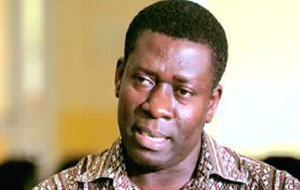
Step 3: Ask for Initial Reactions to the Film.
Ask your audience: “What is your general impression of the video? Do you think it reflects the situation you face in this region generally, and in your community in particular? Why? Why not?”
Step 4: Begin to Discuss Each Part of the Documentary, One Part at a Time.
Discussing Part 1: What to Say
Now, I would like to discuss each part of the documentary. The first part is about the general situation of undernutrition in northern Ghana and some statistics.
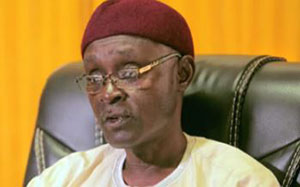
- In the film, it is said that many people believe if a child is short, it is natural, and that the child must come from a family of short people. Do members of your community believe this? What other things do people say in your community about child growth?
Dr. Joseph Opare Laarbi, Deputy Regional Director of Public Health, Upper East Region, describes stunting as “a chronic condition whereby the child does not receive adequate nutrients for a certain period.” What do you think about this statement?
- Do you believe that with good nutrition a child can overcome extreme shortness, even if other family members are very short?
- What do you remember about the statistics related to child undernutrition? What surprised you? What alarmed you? What meaning do you take away from this?
- What are some of the consequences of undernutrition for children, families, and communities mentioned by Dr. Jacob Mahama, acting regional director of health services, Northern Region?
- After hearing this information, has anything changed for you that will make you think differently about young children and their families in your community?
- Do you have any questions about what you have seen up to this point?
- Only 8 percent of children in Ghana under six months of age are stunted, but by the time they reach the age of two, 25 percent are stunted.
- An estimated 720 million Ghana cedis (US$504 million) will be lost in Ghana due to stunting and poor child growth in Ghana between 2011 and 2020.
After participants respond, mention any of the following consequences of undernutrition they may have missed:
- Children do not grow well physically or mentally.
- Children do not perform well in school and leave school early.
- Children become adults who do not have the skills to advance in their jobs.
- Families continue to suffer from lack of productivity and income.
Discussing Part 2: What to Say
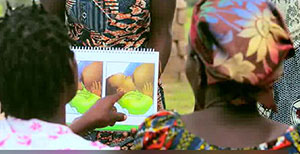
The second part of the video shows the roles that families, leaders, professionals, and community members can play to address child undernutrition. The segment opens at 10:33 minutes into the video, with the drummer and men gathering at the chief’s house.
- The video made a point to say that not all of the burden for children’s nutrition should be placed on women and mothers. Is this usually the way people in your community think of this topic? Why or why not? If so, what do you think it would take to change the belief that women and mothers are solely responsible for child nutrition?
- What are some of the things leaders in the documentary are encouraging mothers and caregivers to do to ensure a healthy environment and diet for young children?
After asking for examples of the actions of traditional leaders, remind participants of the actions some leaders in the video are taking. If necessary, remind them of:
- The First Elder of Nayiri: Visits local health centers and observes growth monitoring activities to make sure that household members, including men, actively participate.
- The Chief of Atampintin: Reminds fathers to use some of their money to purchase liver, fish, and eggs for young children over six months of age and to take meat home to their families.
- The Chief Imam: Encourages men to take an active role in caring for children, including making sure that there is food other than grain for their young children.
- The Sanitation Officer: Helps men and other family members build latrines and hand- washing stations and use them properly.
After the discussion, inform participants that if they do not regularly see the actions depicted in the documentary in their communities, it is important that they begin thinking of the problems they may want to address. These will be discussed further in the Action Planning session.
Discussing Part 3: What to Say
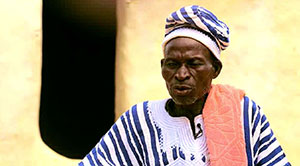
The final part of the video calls on leaders to take action. This section starts at 18:51 and opens with the sun rising.
- The Chief of Atampintin, Awumbilla Ayaa, calls for households, especially husbands, to do what is needed to help their wives and newborns obtain the nutrients required to prevent stunting. What is needed in your own community to encourage men to take this action?
- What actions can traditional and community leaders take immediately to reduce the poor growth of young children in this community?
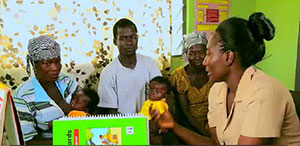
- What specific roles can male heads of households take in your community to address child undernutrition?
- What are the biggest barriers preventing men and leaders in your community from taking action to improve child nutrition?
- Thinking of your community, and your role as a leader, name some groups you think your community should prioritize? What are some platforms leaders could use to do this work (e.g., types of community meetings, religious gatherings, radio)?
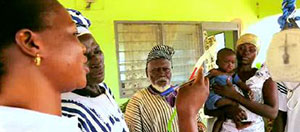
- What are key organized groups that you could work with in your community? Can you think of opportunities to reach community members in large groups (e.g., gatherings of community members that are not formally organized, community events)?
Step 5: Action Planning and Making Commitments
In this section, you will divide participants into small discussion groups to develop action plans.
Guidance for Organizing Action Planning Discussion Groups
- Keep the groups small—no more than six to eight people per group.
- If participants have come to the meeting with members of a group they belong to, try to keep those individuals together, if possible. It is likely that they will eventually develop and implement their own community action plans together.
- If participants represent different organizations and/or religious groups, organize the groups in a way that makes sense given local norms—whether by position in the community, geographical location, institution represented (e.g., church, mosque, district management team), or the like.
- Ensure that different levels of authority are respected and that the groups are structured so that it is easy for all members to participate. For example, would everyone participate if you combined a group of senior imams or pastors with leaders of mother-to-mother groups?
- Organize groups in a way that facilitates natural collaboration to achieve goals. For example, all of a group’s participants should be working in the same geographic location (i.e., the same community), with the same types of organizations (i.e., religious groups), or with the same community groups.
The small groups you form will be tasked with developing an action plan to address child undernutrition, an action plan that the groups can implement in the course of their everyday activities.
Make sure to tell groups that SPRING and district facilitators will follow up with them on their action plan. The group should be able to work together to implement their plan.
Group Work Instructions
- After participants have gathered in their groups, distribute the Action Plan Form (Annex 3).
- Ask each group to assign a facilitator and a recorder.
- Ask groups to think about the video and group discussion and complete the Action Plan Form by first identifying a key problem related to child undernutrition that they want to address in their community. The group needs to focus on one or two problems—no more—specifically, problems that can be addressed within the team’s day-to-day activities and given that group’s resources. For example, religious leaders could decide to use worship services, their own platform, to make public statements about child nutrition and the problems associated with stunting and poor growth. Activities chosen should not require a budget to implement or require a technical skill from outside of the group (and thus can be integrated into the group’s ongoing activities).
- Record the selected problem on the Action Plan Form.
- Have groups discuss and complete the rest of the worksheet, answering how their group will implement the strategy; where in the community will it be implemented; when, on a realistic timeline for completion; and with whom (e.g., fathers, mothers, other religious leaders, and health personnel as well as potential collaborators like district health officers and district environmental officers).
- Identify the team member who will be the contact person for each group and record his or her name, phone number, and location on the form.
- Invite one member from each group to quickly share the group’s action plan. Instruct groups to take no more than five minutes to present. Allow other participants to ask questions.
- Record each group’s action plan for SPRING, and leave a copy with each team.
Step 6: Wrap-Up and Close
- Restate the key messages and remind participants that SPRING representatives will conduct follow-up visits with those who have made commitments to progress.
- Tell the group that the SPRING team and community health workers are available to assist in implementation and to follow up on the action plans.
- Thank participants for their time and commitment.
To view the annexes, please download the full report above.